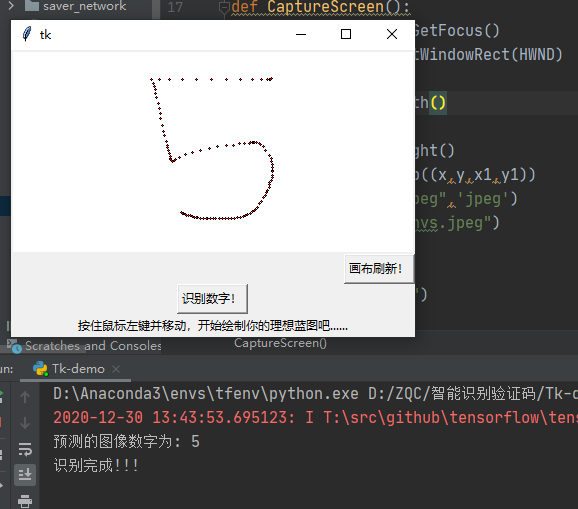|
|
马上注册,结交更多好友,享用更多功能^_^
您需要 登录 才可以下载或查看,没有账号?立即注册
x
- import tensorflow as tf
- from tensorflow.examples.tutorials.mnist import input_data
- import numpy as np
- from PIL import Image
- #算法超参数
- batch_size=100
- training_epochs=10
- learning_rate_init=0.01
- display_step=100
- #网络参数
- n_input=784
- n_classes=10
- #根据指定的维数返回指定的权数
- def WeightsVariable(shape,name_str,stddev=0.1):
- """
- :param shape: 形状,n行n列
- :param name_str: 变量名称
- :param stddev: 正态分布标准差
- :return:
- """
- initial=tf.random_normal(shape=shape,stddev=stddev,dtype=tf.float32)
- return tf.Variable(initial_value=initial,dtype=tf.float32,name=name_str)
- #根据指定维数返回指定的偏置
- def BiasesVariable(shape,name_str,stddev=0.1):
- """
- :param shape: 偏置的形状,nxn
- :param name_str: 变量名称
- :param stddev: 正态分布标准差
- :return:
- """
- initial=tf.random_normal(shape=shape,stddev=stddev,dtype=tf.float32)
- return tf.Variable(initial_value=initial,dtype=tf.float32,name=name_str)
- #二维卷积层的封装(conv2d+bias)
- def Conv2d(X,w,b,stride=1,padding="SAME"):
- """
- :param X: 特征图输入n*n*None
- :param w: 滤波器(权重参数)
- :param b: 修正(偏置参数)
- :param stride: 滑动步长(默认为1)
- :param padding: 外填充
- :return:
- """
- with tf.name_scope("Conv2d"):
- y=tf.nn.conv2d(X,w,strides=[1,stride,stride,1],padding=padding)
- y=tf.nn.bias_add(y,b)
- return y
- #非线性激活层的封装
- def Activation(x,activation=tf.nn.relu,name="relu"):
- """
- :param x: 特征图输入
- :param activation: 激活函数,类似于看待事物的一种模式
- :param name: 名称
- :return:
- """
- with tf.name_scope(name):
- y=activation(x)
- return y
- #最大池化层的封装
- def Pool2d(x,pool=tf.nn.max_pool,k=2,stride=2):
- return pool(x,ksize=[1,k,k,1],strides=[1,stride,stride,1],padding="VALID")
- #全连接层封装
- def FullyConnect(x,w,b,activate=tf.identity,act_name="identity"):
- with tf.name_scope("Wx_b"):
- y=tf.add(tf.matmul(x,w),b)
- with tf.name_scope("SoftMax"):
- y=tf.nn.softmax(logits=y)
- with tf.name_scope(act_name):
- y=activate(y)
- return y
- #通用的评估函数,用来评估模型在给定的数据集上的损失和准确率
- def EvaluateMode10nDataset(sess,images,labels):
- n_samples=images.shape[0] #传入的样本数量
- per_batch_size=batch_size
- loss=0
- acc=0
- if(n_samples<=per_batch_size):
- batch_count=1
- loss,acc=sess.run([cross_entropy_loss,accuracy],
- feed_dict={X_origin:images,
- Y_true:labels,
- learning_rate:learning_rate_init})
- else:
- batch_count=int(n_samples/per_batch_size)
- batch_start=0
- for idx in range(batch_count):
- batch_loss,batch_acc=sess.run([cross_entropy_loss,accuracy],
- feed_dict={X_origin:images[batch_start:batch_start+per_batch_size,:],
- Y_true:labels[batch_start:batch_start+per_batch_size,:],
- learning_rate:learning_rate_init})
- batch_start+=per_batch_size
- #累计所有批次上的损失和准确率
- loss+=batch_loss
- acc+=batch_acc
- return loss/batch_count,acc/batch_count
- '''计算图绘制'''
- with tf.Graph().as_default():
- #输入层:28*28*1
- with tf.name_scope("Input"):
- X_origin=tf.placeholder(tf.float32,shape=[None,n_input],name="X_origin")
- Y_true=tf.placeholder(tf.float32,shape=[None,n_classes],name="Y_true")
- X_image=tf.reshape(X_origin,[-1,28,28,1],name="X_image")
- #前向推断过程
- with tf.name_scope("Inference"):
- #卷积层第一层:24*24*16
- with tf.name_scope("Conv2d_1"):
- weight_1=WeightsVariable(shape=[5,5,1,16],name_str="weight_1")
- bias_1=BiasesVariable(shape=[16],name_str="bias_1")
- conv1_out=Conv2d(X_image,weight_1,bias_1,stride=1,padding="VALID")
- #非线性激活层
- with tf.name_scope("Active"):
- activation_out=Activation(x=conv1_out,activation=tf.nn.relu,name="relu")
- #池化层(默认采用最大池化)12*12*16
- with tf.name_scope("Pool2d_1"):
- pool1_out=Pool2d(x=activation_out,pool=tf.nn.max_pool,k=2,stride=2)
- #将二维特征图转变为1维,2304
- with tf.name_scope("FeatsReshape"):
- features=tf.reshape(pool1_out,[-1,12*12*16])
- #全连接层
- with tf.name_scope("FC_linear1"):
- weight_fc=WeightsVariable(shape=[12*12*16,n_classes],name_str="weight_fc")
- bias_fc=BiasesVariable(shape=[n_classes],name_str="bias_fc")
- Ypre_logits=FullyConnect(features,weight_fc,bias_fc,activate=tf.identity,act_name="identity")
- #定义损失层
- with tf.name_scope("Loss"):
- cross_entropy_loss = tf.reduce_mean(tf.nn.softmax_cross_entropy_with_logits(
- labels=Y_true, logits=Ypre_logits
- ))
- #定义训练优化层
- with tf.name_scope("Train"):
- global_step = tf.Variable(0, name='global_step', trainable=False)
- learning_rate=tf.placeholder(tf.float32)
- optimizer=tf.train.AdamOptimizer(learning_rate=learning_rate)
- trainer=optimizer.minimize(cross_entropy_loss,global_step=global_step)
- #定义模型评估层
- with tf.name_scope("Evaluate"):
- correct_pred=tf.equal(tf.argmax(Ypre_logits,1),tf.argmax(Y_true,1))
- accuracy=tf.reduce_mean(tf.cast(correct_pred,tf.float32))
- #定义初始化所有变量节点
- init=tf.initialize_all_variables()
- print("将计算图写入log事件文件中,并在tensorboard中查看!!")
- writer=tf.summary.FileWriter("logs/",graph=tf.get_default_graph())
- writer.close()
- # 导入mnist数据集
- mnist=input_data.read_data_sets("MNIST_data/",one_hot=True)
- '''启动会话'''
- with tf.Session() as sess:
- sess.run(init) #初始化variable变量
- total_batches=int(mnist.train.num_examples/batch_size)
- print("每批次的样本数量:",batch_size)
- print("总共的批次数量:",total_batches)
- print("总共的训练数据:",mnist.train.num_examples)
- #保存和载入网络
- saver=tf.train.Saver()
- checkpoint=tf.train.get_checkpoint_state("saver_network")
- if checkpoint and checkpoint.model_checkpoint_path:
- saver.restore(sess,checkpoint.model_checkpoint_path)
- print("Successfully loaded:", checkpoint.model_checkpoint_path)
- else:
- print("Could not find old network weights")
- training_step=0 #记录模型被训练的步数
- #指定训练轮数,将所有的样本都训练一遍
- for epoch in range(training_epochs):
- #把一轮所有的batch都跑一遍
- for batch_idx in range(total_batches):
- # 取出数据
- batch_x, batch_y = mnist.train.next_batch(batch_size)
- #训练优化器训练节点
- sess.run(trainer,feed_dict={
- X_origin:batch_x,
- Y_true:batch_y,
- learning_rate:learning_rate_init,
- })
- #每调用一次训练节点,training_step就加1
- training_step=training_step+1
- # 每训练display_step次,就计算当前模型的损失和准确率
- if training_step % display_step == 0:
- start_idx = max(0, (batch_idx - display_step) * batch_size)
- end_idx = batch_idx * batch_size
- train_loss, train_acc = EvaluateMode10nDataset(sess,
- mnist.train.images[start_idx:end_idx, :],
- mnist.train.labels[start_idx:end_idx, :])
- print("Training Step:" + str(training_step) +
- ",Training_Loss={:.6f}".format(train_loss) +
- ",Training_accuracy={:.5f}".format(train_acc))
- # 计算当前模型在验证集上的损失和准确率
- validation_loss, validation_acc = EvaluateMode10nDataset(sess,
- mnist.validation.images,
- mnist.validation.labels)
- print("Training Step:" + str(training_step) +
- ",Validation_Loss={:.6f}".format(validation_loss) +
- ",Validation_accuracy={:.5f}".format(validation_acc))
- if training_step%display_step==0:
- saver.save(sess,"./saver_network/check_mnist",global_step=global_step)
- print("训练完毕!!!")
- img = Image.open("5.png")
- img = img.convert('L') # 灰度化
- img = np.reshape(img, (784, 1)).reshape(1, 784)
- img = ((255 - np.array(img, dtype=np.uint8)) / 255.0).reshape(1, 784)
- logits=sess.run(Ypre_logits,feed_dict={
- X_origin:img
- })
- print("预测的图像数字为:",np.argmax(logits))
- if __name__ == '__main__':
- pass
|
-

|
 ( 粤ICP备18085999号-1 | 粤公网安备 44051102000585号)
( 粤ICP备18085999号-1 | 粤公网安备 44051102000585号)